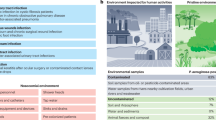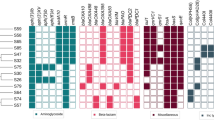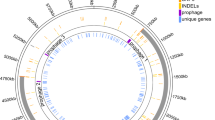Abstract
The rapid emergence of antibiotic resistant bacterial pathogens constitutes a critical problem in healthcare and requires the development of novel treatments. Potential strategies include the exploitation of microbial social interactions based on public goods, which are produced at a fitness cost by cooperative microorganisms, but can be exploited by cheaters that do not produce these goods. Cheater invasion has been proposed as a ‘Trojan horse’ approach to infiltrate pathogen populations with strains deploying built-in weaknesses (e.g., sensitiveness to antibiotics). However, previous attempts have been often unsuccessful because population invasion by cheaters was prevented by various mechanisms including the presence of spatial structure (e.g., growth in biofilms), which limits the diffusion and exploitation of public goods. Here we followed an alternative approach and examined whether the manipulation of public good uptake and not its production could result in potential ‘Trojan horses’ suitable for population invasion. We focused on the siderophore pyoverdine produced by the human pathogen Pseudomonas aeruginosa MPAO1 and manipulated its uptake by deleting and/or overexpressing the pyoverdine primary (FpvA) and secondary (FpvB) receptors. We found that receptor synthesis feeds back on pyoverdine production and uptake rates, which led to strains with altered pyoverdine-associated costs and benefits. Moreover, we found that the receptor FpvB was advantageous under iron-limited conditions but revealed hidden costs in the presence of an antibiotic stressor (gentamicin). As a consequence, FpvB mutants became the fittest strain under gentamicin exposure, displacing the wildtype in liquid cultures, and in biofilms and during infections of the wax moth larvae Galleria mellonella, which both represent structured environments. Our findings reveal that an evolutionary trade-off associated with the costs and benefits of a versatile pyoverdine uptake strategy can be harnessed for devising a Trojan-horse candidate for medical interventions.
Similar content being viewed by others
Log in or create a free account to read this content
Gain free access to this article, as well as selected content from this journal and more on nature.com
or
References
West SA, Griffin AS, Gardner A. Social semantics: altruism, cooperation, mutualism, strong reciprocity and group selection. J Evol Biol. 2007;20:415–32.
Özkaya Ö, Xavier KB, Dionisio F, Balbontín R. Maintenance of microbial cooperation mediated by public goods in single- and multiple-trait scenarios. J Bacteriol. 2017;199:e00297–17.
Brown SP, West SA, Diggle SP, Griffin AS. Social evolution in micro-organisms and a Trojan horse approach to medical intervention strategies. Philos Trans R Soc B Biol Sci. 2009;364:3157–68.
Rezzoagli C, Granato ET, Kümmerli R. In-vivo microscopy reveals the impact of Pseudomonas aeruginosa social interactions on host colonization. ISME J. 2019;13:2403–14.
Granato ET, Ziegenhain C, Marvig RL, Kümmerli R. Low spatial structure and selection against secreted virulence factors attenuates pathogenicity in Pseudomonas aeruginosa. ISME J. 2018;12:2907–18.
Bruger E, Waters C. Sharing the sandbox: evolutionary mechanisms that maintain bacterial cooperation. F1000Research. 2015;4:1504.
Griffin AS, West SA, Buckling A. Cooperation and competition in pathogenic bacteria. Earth. 2004;430:1024–7.
Nadal Jimenez P, Koch G, Thompson JA, Xavier KB, Cool RH, Quax WJ. The multiple signaling systems regulating virulence in Pseudomonas aeruginosa. Microbiol Mol Biol Rev. 2012;76:46–65.
Ringel MT, Brüser T. The biosynthesis of pyoverdines. Micro Cell. 2018;5:424–37.
Butaitė E, Baumgartner M, Wyder S, Kümmerli R. Siderophore cheating and cheating resistance shape competition for iron in soil and freshwater Pseudomonas communities. Nat Commun. 2017;8:414.
Harrison F, Browning LE, Vos M, Buckling A. Cooperation and virulence in acute Pseudomonas aeruginosa infections. BMC Biol. 2006;4:21.
Meyer J-M, Stintzi A, Poole K. The ferripyoverdine receptor FpvA of Pseudomonas aeruginosa PAO1 recognizes the ferripyoverdines of P. aeruginosa PAO1 and ATCC 13525. FEMS Microbiol Lett. 1999;170:145–50.
Ghysels B, Dieu BTM, Beatson SA, Pirnay J-P, Ochsner UA, Vasil ML, et al. FpvB, an alternative type I ferripyoverdine receptor of Pseudomonas aeruginosa. Microbiology. 2004;150:1671–80.
Imperi F, Tiburzi F, Visca P. Molecular basis of pyoverdine siderophore recycling in Pseudomonas aeruginosa. Proc Natl Acad Sci. 2009;106:20440–5.
Rédly GA, Poole K. Pyoverdine-mediated regulation of FpvA synthesis in Pseudomonas aeruginosa: involvement of a probable extracytoplasmic-function sigma factor, FpvI. J Bacteriol. 2003;185:1261–5.
Bishop TF, Martin LW, Lamont IL. Activation of a cell surface signaling pathway in Pseudomonas aeruginosa requires ClpP protease and new sigma factor synthesis. Front Microbiol. 2017;8:2442.
Lamont IL, Beare PA, Ochsner U, Vasil AI, Vasil ML. Siderophore-mediated signaling regulates virulence factor production in Pseudomonas aeruginosa. Proc Natl Acad Sci U S A. 2002;99:7072–7.
Spencer MR, Beare PA, Lamont IL. Role of cell surface signaling in proteolysis of an alternative sigma factor in Pseudomonas aeruginosa. J Bacteriol. 2008;190:4865–9.
Leoni L, Ciervo A, Orsi N, Visca P. Iron-regulated transcription of the pvdA gene in Pseudomonas aeruginosa: effect of Fur and PvdS on promoter activity. J Bacteriol. 1996;178:2299–313.
Schulz S, Eckweiler D, Bielecka A, Nicolai T, Franke R, Dötsch A, et al. Elucidation of sigma factor-associated networks in Pseudomonas aeruginosa reveals a modular architecture with limited and function-specific crosstalk. PLoS Pathog. 2015;11:e1004744.
Dao K-HT, Hamer KE, Clark CL, Harshman LG. Pyoverdine production by Pseudomonas aeruginosa exposed to metals or an oxidative stress agent. Ecol Appl. 1999;9:441–8.
Vasse M, Noble RJ, Akhmetzhanov AR, Torres-Barceló C, Gurney J, Benateau S, et al. Antibiotic stress selects against cooperation in the pathogenic bacterium Pseudomonas aeruginosa. Proc Natl Acad Sci U S A. 2017;114:546–51.
Ratjen F, Brockhaus F, Angyalosi G. Aminoglycoside therapy against Pseudomonas aeruginosa in cystic fibrosis: a review. J Cyst Fibros. 2009;8:361–9.
Zobel S, Benedetti I, Eisenbach L, de Lorenzo V, Wierckx N, Blank LM. Tn7-based device for calibrated heterologous gene expression in Pseudomonas putida. ACS Synth Biol. 2015;4:1341–51.
Kümmerli R, Griffin AS, West SA, Buckling A, Harrison F. Viscous medium promotes cooperation in the pathogenic bacterium Pseudomonas aeruginosa. Proc Biol Sci. 2009;276:3531–8.
Dobay A, Bagheri HC, Messina A, Kümmerli R, Rankin DJ. Interaction effects of cell diffusion, cell density and public goods properties on the evolution of cooperation in digital microbes. J Evol Biol. 2014;27:1869–77.
Tsai CJ-Y, Loh JMS, Proft T. Galleria mellonella infection models for the study of bacterial diseases and for antimicrobial drug testing. Virulence. 2016;7:214–29.
Weigert M, Ross-Gillespie A, Leinweber A, Pessi G, Brown SP, Kümmerli R. Manipulating virulence factor availability can have complex consequences for infections. Evol Appl. 2017;10:91–101.
Andersen SB, Shapiro BJ, Vandenbroucke-Grauls C, de Vos MGJ. Microbial evolutionary medicine: from theory to clinical practice. Lancet Infect Dis. 2019;19:e273–83.
Hancock REW, Marr AK, Overhage J, Bains M. The Lon protease of Pseudomonas aeruginosa is induced by aminoglycosides and is involved in biofilm formation and motility. Microbiology. 2007;153:474–82.
Linares JF, Gustafsson I, Baquero F, Martinez JL. Antibiotics as intermicrobial signaling agents instead of weapons. Proc Natl Acad Sci U S A. 2006;103:19484–9.
Jin Z, Li J, Ni L, Zhang R, Xia A, Jin F. Conditional privatization of a public siderophore enables Pseudomonas aeruginosa to resist cheater invasion. Nat Commun. 2018;9:1383.
James HE, Beare PA, Martin LW, Lamont IL. Mutational analysis of a bifunctional ferrisiderophore receptor and signal-transducing protein from Pseudomonas aeruginosa. J Bacteriol. 2005;187:4514–20.
Andersen SB, Marvig RL, Molin S, Krogh Johansen H, Griffin AS. Long-term social dynamics drive loss of function in pathogenic bacteria. Proc Natl Acad Sci. 2015;112:10756–61.
Dingemans J, Ye L, Hildebrand F, Tontodonati F, Craggs M, Bilocq F, et al. The deletion of TonB-dependent receptor genes is part of the genome reduction process that occurs during adaptation of Pseudomonas aeruginosa to the cystic fibrosis lung. Pathog Dis. 2014;71:26–38.
Ross‐Gillespie A, Gardner A, West SA, Griffin AS. Frequency dependence and cooperation: theory and a test with bacteria. Am Nat. 2007;170:331–42.
Tyrrell J, Callaghan M. Iron acquisition in the cystic fibrosis lung and potential for novel therapeutic strategies. Microbiology. 2016;162:191–205.
Jander G, Rahme LG, Ausubel FM. Positive correlation between virulence of Pseudomonas aeruginosa mutants in mice and insects. J Bacteriol. 2000;182:3843–5.
Granato ET, Harrison F, Kümmerli R, Ross-Gillespie A. Do bacterial ‘virulence factors’ always increase virulence? A meta-analysis of pyoverdine production in Pseudomonas aeruginosa as a test case. Front Microbiol. 2016;7:1952.
Pereira T, de Barros P, Fugisaki L, Rossoni R, Ribeiro F, de Menezes R, et al. Recent advances in the use of Galleria mellonella model to study immune responses against human pathogens. J Fungi. 2018;4:128.
Andrejko M, Mizerska-Dudka M. Effect of Pseudomonas aeruginosa elastase B on level and activity of immune proteins/peptides of Galleria mellonella hemolymph. J Insect Sci. 2012;12:1–14.
Fothergill JL, Neill DR, Loman N, Winstanley C, Kadioglu A. Pseudomonas aeruginosa adaptation in the nasopharyngeal reservoir leads to migration and persistence in the lungs. Nat Commun. 2014;5:4780.
Jacobs MA, Alwood A, Thaipisuttikul I, Spencer D, Haugen E, Ernst S, et al. Comprehensive transposon mutant library of Pseudomonas aeruginosa. Proc Natl Acad Sci U S A. 2003;100:14339–44.
Wickham H. ggplot2: elegant graphics for data analysis. New York, NY:Springer-Verlag; 2016.
Kassambara A, Kosinski M, Biecek P, Fabian S. survminer: Survival analysis and visualization, R package version 0.3 1. 2017.
Swain PS, Stevenson K, Leary A, Montano-Gutierrez LF, Clark IBN, Vogel J, et al. Inferring time derivatives including cell growth rates using Gaussian processes. Nat Commun. 2016;7:13766.
Acknowledgements
The authors would like to thank Dr Melanie Ghoul, Prof. Stuart West and Prof. Craig McLean (University of Oxford), and Dr Jorge Gutiérrez (University of Surrey) for the insightful discussions on population invasion and their constructive feedback on the manuscript. The authors are indebted to Dr Helen King, Dr Mandy Fivian-Hughes and Anita Sicilia for their technical assistance. JG was the recipient of a PhD studentship of the University of Surrey and an EMBO Short-Term Fellowship (ASFT number: 8166). CAR and JIJ acknowledge the support received from the Biotechnology and Biological Sciences Research Council (BBSRC) (Grants BB/L02683X/1 and BB/T011289/1 from the ERA-Cobiotech programme of the EU). MSpi, CC and MJB acknowledge the support from the Engineering and Physical Sciences Research Council through a strategic equipment grant (EP/P001440/1). RK has received funding from the European Research Council (ERC) under the European Union’s Horizon 2020 research and innovation programme (grant agreement no. 681295). ÖÖ has received funding from the Forschungskredit by the University of Zurich.
Author information
Authors and Affiliations
Contributions
JG, CAR, RK and JIJ designed and supervised the study. JG, MSal, ÖÖ, KR, MSpi and CC conducted experimental work. All authors analysed the data and wrote the manuscript.
Corresponding author
Ethics declarations
Conflict of interest
The authors declare that they have no conflict of interest.
Additional information
Publisher’s note Springer Nature remains neutral with regard to jurisdictional claims in published maps and institutional affiliations.
Supplementary information
Rights and permissions
About this article
Cite this article
González, J., Salvador, M., Özkaya, Ö. et al. Loss of a pyoverdine secondary receptor in Pseudomonas aeruginosa results in a fitter strain suitable for population invasion. ISME J 15, 1330–1343 (2021). https://doi.org/10.1038/s41396-020-00853-2
Received:
Revised:
Accepted:
Published:
Issue date:
DOI: https://doi.org/10.1038/s41396-020-00853-2
This article is cited by
-
Exploiting social traits for clinical applications in bacteria and viruses
npj Antimicrobials and Resistance (2025)
-
Experimental evolution of yeast shows that public-goods upregulation can evolve despite challenges from exploitative non-producers
Nature Communications (2024)



